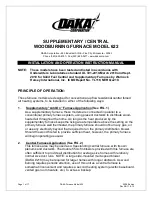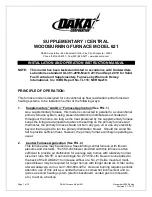
SYSTEM OPERATION
19
When the furnace is installed without a cooling coil, it is
recommended that a removable access panel be provided
in the outlet air duct. This opening shall be accessible
when the furnace is installed and shall be of such a size
that the heat exchanger can be viewed for visual light
inspection or such that a sampling probe can be inserted
into the airstream. The access panel must be made to
prevent air leaks when the furnace is in operation.
When the furnace is heating, the temperature of the return
air entering the furnace must be between 55°F and 100°F.
Filters must be used with this furnace. Discuss filter
maintenance with the building owner. Filters do not ship
with this furnace, but must be provided, sized and installed
externally by the installer. Filters must comply with UL900
or CAN/ULCS111 standards. Damage or repairs due to
the installation of the furnace without filters is not covered
under the warranty.
Depending on the installation and/or customer preference,
differing filter arrangements can be applied. Filters can
be installed in the central return register or a side panel
external filter rack kit (upflows). As an alternative a media
air filter or electronic air cleaner can be used as the
requested filter. Consider installing an air cleaner with
deep-pleated media filter at the time of furnace installation.
A deep-pleated filter with a MERV rating of 8 (minimum) will
often provide better filtration to protect equipment and the
air distribution system than a standard 1” filter and often
has lower static pressure loss than a 1” filter. Also a deep-
pleated filter will typically require less frequent replacement
intervals. Avoid using highly restrictive 1” filters which
produce static pressure loss greater than .25” W.C. In
some installations the minimum filter size required will not
lend itself to a filter installation on the side of the furnace.
The installation of a centrally installed air cleaner cabinet or
a return duct filter installation may offer more practicality.
Clean Comfort™ brand MERV 11 air cleaners have
5¼” media filters and are available in the following
configurations. Consult your distributor for information on
our complete line of IAQ Clean Comfort™ products.
Gas Supply Pressure Measurement
White-Rodgers Model 36J54 (Two-Stage)
Manometer
Manometer
Hose
High Fire Regulator
Adjust
Regulator
Vent
On/Off Switch
High Fire Coil
Terminal (HI)
Coaxial Coil
Terminal (M)
Common
Terminal(C)
White-Rodgers Model 36J54 Connected to Manometer
3.5
Inlet Gas Supply Pressure
Natural Gas
Minimum: 4.5” w.c. Maximum: 10.0” w.c.
Propane Gas
Minimum: 11.0” w.c. Maximum: 13.0” w.c.
CAUTION
To prevent unreliable operation or equipment
damage, the inlet gas supply pressure must
be as specified on the unit rating plate with
all other household gas fired appliances
operating.
The line pressure supplied to the gas valve must be within
the range specified below. The supply pressure can be
measured at the gas valve inlet pressure tap or at a hose
fitting installed in the gas piping drip leg. The supply
pressure must be measured with the burners operating.
To measure the gas supply pressure, use the following
procedure.
1.
Turn OFF gas to furnace at the manual gas shutoff valve
external to the furnace.
2. Connect a calibrated water manometer (or appropriate
gas pressure gauge) at either the gas valve inlet pressure
tap or the gas piping drip leg. See White-Rodgers 36J54
gas valve figure for location of inlet pressure tap.
















































